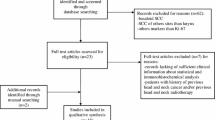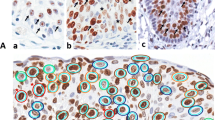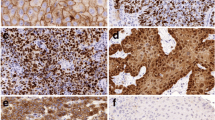Abstract
Laryngeal precursor lesions represent areas of altered epithelium with an increased likelihood for progression to squamous cell carcinoma. The exact molecular mechanisms of malignant transformation of laryngeal mucosa are not completely clear, but are certainly due to deregulation of cell proliferation. To assess the potential value of the p16 and Ki-67 as markers of malignant progression, we undertook a retrospective immunohistochemical and morphometric analysis on biopsy specimens from patients with precancerous lesions in the larynx. Morphometric analysis of samples stained with p16 antibody showed epithelial cell positivity in 29 (100 %) of samples with simple hyperplasia, 31 (100 %) samples with basal/parabasal cell hyperplasia, 23 (88 %) samples with atypical hyperplasia and 20 (95 %) samples with in situ carcinoma. There was a significant difference in percentage of p16-positive cells between samples with simple hyperplasia and samples with in situ carcinoma. Morphometric analysis of samples stained with Ki-67 antibody showed epithelial cell positivity in 27 (93 %) of samples with simple hyperplasia, 30 (97 %) samples with basal/parabasal cell hyperplasia, 26 (100 %) samples with atypical hyperplasia and 18 (86 %) samples with in situ carcinoma. There was a significant difference not only in the percentage of Ki-67-positive cells between samples with simple hyperplasia and samples with in situ carcinoma, but also between samples with simple and basal/parabasal cell hyperplasia. Laryngeal epithelial precursor lesions show significantly opposite patterns in p16 and Ki-67 immunopositivity. Simple hyperplasia on average shows 12 % of Ki-67-positive cells and 46 % of p16-positive cells. In situ carcinoma on average shows 23 % of Ki-67-positive cells and 36 % of p16-positive cells.




Similar content being viewed by others
References
Gale N, Pilch BZ, Sidransky D et al (2005) Epithelial precursor lesions. In: Barnes L, Eveson JW, Reichart P, Sidransky D (eds) World Health Organisation classification of tumours. Pathology and genetics of head and neck tumours. IARC Press, Lyon, pp 140–143
Gale N, Michaels L, Luzar B et al (2008) Current review on squamous intraepithelial lesions of the larynx. Histopathology 54:639–656
Hobbs CG, Sterne JA, Bailey M et al (2006) Human papillomavirus and head and neck cancer: a systematic review and meta-analysis. Clin Otolaryngol 31:259–266
Kleist B, Junghans G, Bankau A, Poetsch M (2003) The supplementary diagnostic power of selected immunohistochemical, molecular, genetic and infective parameters in epithelial hyperplastic laryngeal lesions. Oncology 65:347–354
Laco J, Slaninka I, Jirásek M et al (2008) High-risk human papillomavirus infection and p16INK4a protein expression in laryngeal lesions. Pathol Res Pract 204:545–552
Nadal A, Cardesa A (2003) Molecular biology of laryngeal squamous cell carcinoma. Virchows Arch 442:1–7
Fleskens S, Slootweg P (2009) Grading systems in head and neck dysplasia: their prognostic value, weaknesses and utility. Head Neck Oncol 1:11
Mithani SK, Mydlarz WK, Grumbine FL et al (2007) Molecular genetics of premalignant oral lesions. Oral Dis 13:126–133
Bradley KT, Budnick SD, Logani S (2006) Immunohistochemical detection of p16INK4a in dysplastic lesions of the oral cavity. Mod Pathol 19:1310–1316
Papadimitrakopoulou V, Izzo J, Lippman SM (1997) Frequent inactivation of p16INK4a in oral premalignant lesions. Oncogene 14:1799–1803
Zhang L, Rosin MP (2001) Loss of heterozygosity: a potential tool in management of oral premalignant lesions? J Oral Pathol Med 30:513–520
Jares P, Fernández PL, Nadal A et al (1997) p16MTS1/CDK4I mutations and concomitant loss of heterozygosity at 9p21–23 are frequent events in squamous cell carcinoma of the larynx. Oncogene 15:1445–1453
Wayne S, Robinson RA (2006) Upper aerodigestive tract squamous dysplasia. Arch Pathol Lab Med 130:1309–1314
Hardisson D (2003) Molecular pathogenesis of head and neck squamous cell carcinoma. Eur Arch Otorhinolaryngol 260:502–508
Sano T, Oyama T, Kashiwathara K et al (1998) Expression status of p16 protein is associated with human papillomavirus oncogenic potential in cervical and genital lesions. Am J Pathol 153:1741–1748
Regauer S, Reich O (2007) CK17 and p16 expression patterns distinguish (atypical) immature squamous metaplasia from high-grade cervical intraepithelial neoplasia (CIN III). Histopathology 50:629–635
Pich A, Chiusa L, Navone R (2004) Prognostic relevance of cell proliferation in head and neck tumors. Ann Oncol 15:1319–1329
Scholzen T, Gerdes J (2000) The Ki-67 protein: from the known and the unknown. J Cell Physiol 182:311–322
Şengiz S, Pabuççuoğlu U, Sarioğlu S (2004) Immunohistological comparison of the World Health Organisation (WHO) and Ljubljana classifications on the grading of preneoplastic lesions of the larynx. Pathol Res Pract 200:181–188
Kręcicki T, Jeleń M, Zalesska-Kręcicka M et al (1999) Epidermal growth factor receptor (EGFR), proliferating nuclear antigen (PCNA) and Ki-67 antigen in laryngeal epithelial lesions. Oral Oncol 35:180–186
Dispenza F, Di Stefano A, Marchese D et al (2012) Management of laryngeal precancerous lesions. Auris Nasus Larynx 39(3):280–283
Isenberg JS, Crozier DL, Dailey SH (2008) Institutional and comprehensive review of laryngeal leukoplakia. Ann Otol Rhinol Laryngol 117:74–79
Koren R, Kristt D, Shvero J et al (2002) The spectrum of laryngeal neoplasia: the pathologist’s view. Pathol Res Pract 198:709–715
Zidar N, Gale N, Cör A, Kambič V (1996) Expression of Ki-67 antigen and proliferative cell nuclear antigen in benign and malignant epithelial lesions of the larynx. J Laryngol Otol 110:440–445
Wing Yuen P, Man M, Yin Lam K, Lam Kwong Y (2002) Clinicopathological significance of p16 gene expression in the surgical treatment of head and neck squamous cell carcinomas. J Clin Pathol 55:58–60
Pignataro L, Cappacio P, Pruneri G et al (1998) The predictive value of p53, MDM-2, cyclin Dl and Ki67 in the progression from low-grade dysplasia towards carcinoma of the larynx. J Laryngol Otol 112:455–459
Izawa H, Yonemitsu N, Shin T, Sugihara H (1999) Histopathological analysis of apoptosis, and expression of p53, bcl-2, bax, and Ki-67 in laryngeal squamous cell carcinomas and dysplasia. Auris Nasus Larynx 26:317–330
Asraf MJ, Maghbul M, Azapira N et al (2010) Expression of Ki-67 and p53 in primary squamous cell carcinoma of the larynx. Indian J Pathol Microbiol 53:661–665
Chatrah P, Scott IS, Morris LS (2003) Aberrant expression of minichromosome maintenance protein-2 and Ki67 in laryngeal squamous epithelial lesions. Br J Cancer 89:1048–1054
Gallo O, Santucci M, Franchi A (1997) Cumulative prognostic value of p16/CDKN2 oncoprotein expression in premalignant laryngeal lesions. J Natl Cancer Inst 89:1161–1163
Eversole LR (2009) Dysplasia of the upper aerodigestive tract squamous epithelium. Head Neck Pathol 3:63–68
Ethical standard
Ethical Committee of Belgrade University School of Medicine approved this work (Morphometric analysis of Ki-67 and p16 expression in laryngeal precursor lesions) for publication.
Author information
Authors and Affiliations
Corresponding author
Rights and permissions
About this article
Cite this article
Pavlovic, B., Djukic, V., Milovanovic, J. et al. Morphometric analysis of Ki-67 and p16 expression in laryngeal precursor lesions. Eur Arch Otorhinolaryngol 270, 1405–1410 (2013). https://doi.org/10.1007/s00405-013-2383-6
Received:
Accepted:
Published:
Issue Date:
DOI: https://doi.org/10.1007/s00405-013-2383-6




